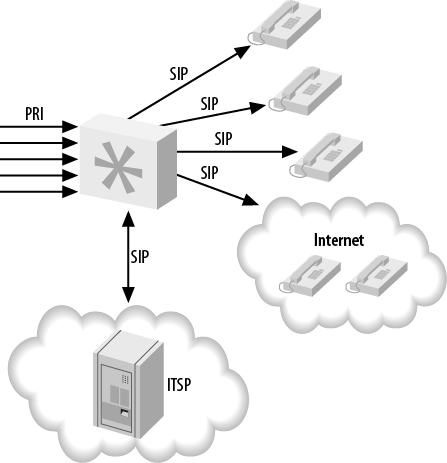The next step in our journey is the pure Asterisk system. In this system we’ve successfully migrated away from the existing PBX system and are now handling all functionality through Asterisk. Our existing PRI has been attached to Asterisk, and we’ve expanded our capacity by integrating an Internet Telephony Service Provider (ITSP) into our system. All agents are now using SIP phones, and we’ve even added several remote employees. This topology is illustrated in Figure 22.3, “Nondistributed Asterisk”.
Remote employees can be a great advantage for a company. Not only can letting your work from remote locations increase employee morale by alleviating the burden of a potentially long commute, but it allows employees to work in an environment they are comfortable in, which can make them more productive. Furthermore, the call center manager does not have any less control over statistics from employees; their calls can still be monitored for training purposes, and the statistical data gathered look no different to the manager than they do for employees residing at the facility.
A measurable advantage for the company is the reduction in the amount of hardware required to be purchased for each employee. If agents can utilize their existing computer systems, electrical grids, and Internet connections, the company can save a significant amount of money by supporting remote employees. Additionally, those employees can be located across the globe to expand the number of hours your agents are available, thereby allowing you to serve more time zones.
Using this system is simple and efficient, but as the company grows, the system may reach a capacity issue. We’ll look at how the system can be expanded later in this chapter.
